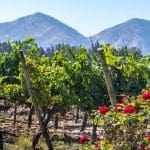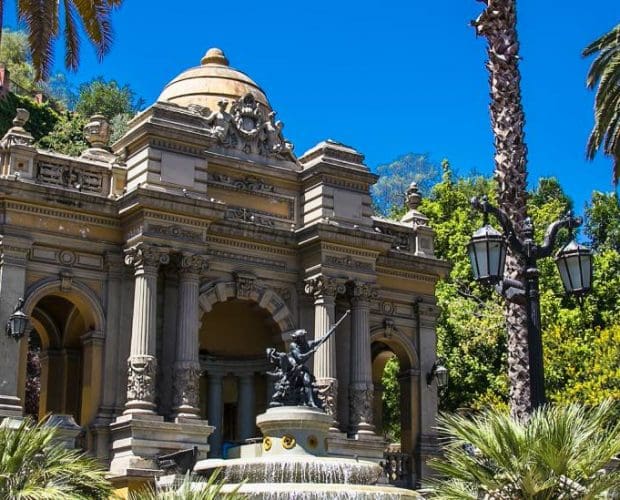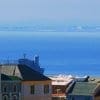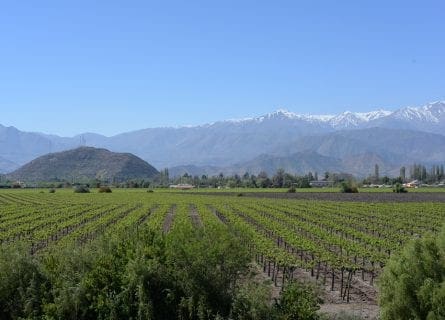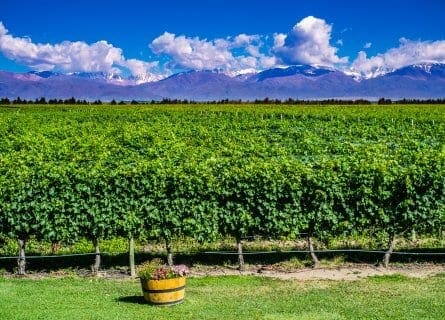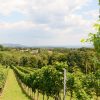
Central Valley Wine Region Guide
Central Valley – Discover the Soul of Chilean Wine.
EXPLORE ALL OUR GUIDES TO CHILE'S WINE REGIONS
Last updated: February 24, 2025
Introduction
Over 85 percent of all Chilean wine is made in the iconic Central Valley, an elongated super region that is both incredibly diverse and stunningly beautiful. First planted to vines in the 1500s (a gift from European settlers), it has been transformed into a powerhouse of voluptuous and intensely fruity red wine, covering deluxe brands made by leading oenologists, high-volume bulk labels, and everything in between. Its trump card, to date, is supremely classy and voluptuous Cabernet Sauvignon – the best examples can outscore First Growths in blind tastings! Much like producers in the Napa Valley, Chilean artisans have a knack for coaxing the maximum finesse – and flavor – out of Cabernet.
Yet while red grapes dominate overall, cooler terroirs are now yielding some very impressive Chardonnay and Sauvignon Blanc; the development of coastal sites and mountain vineyards is all the rage in 2024. Without any doubt, this is Chile’s most remarkable success story of the modern age. It offers choice, quality, excitement, and value in spades. To discover the Central Valley is to understand this country’s viticultural soul.
Geography and terroir

It is impossible to overestimate the importance of the Central Valley to South America’s wine economy. With approximately 118,000 hectares under vine and an expanding portfolio of different varieties, the region is an undisputed export superstar, full of innovative producers, up-and-coming wineries, and long-established names. Stretching for more than 1,400 kilometers from north to south, it begins in Maipo (just south of Chile’s capital, Santiago) and finishes in the southern tip of the Maule Valley. Since the 16th century, these fertile, colluvial soils have been producing high-quality wine, a result of glacial erosion that took place over millions of years, transferring silt, rock, sand, and clay particles from the Andes to the valley below.
Today, there is no shortage of old vines in this viticultural paradise, despite the rush to plant French grapes – and rip out the underrated Pais – at the turn of the century. Fortunately, Chilean growers are rediscovering their love for this unique grape, greatly encouraged by the pioneering efforts of Miguel Torres Jr. In addition, the revolutionary VIGNO project has seen a resurgence in the production of old vine Carignan, joined by Semillon, Cinsault, and Moscatel. Safeguarding tradition has become a guiding philosophy in the vineyards of the Central Valley, hitherto preoccupied with marketing tried-and-tested varietals.
But, while experimentation continues apace, Cabernet Sauvignon (and, to a lesser extent, Merlot) remain the Central Valley’s most prized exports. Indeed, as anyone who has tasted Viñedo Chadwick can testify, the best wines are on a level with Lafite and Latour: they have unparalleled depth and concentration, balanced by a fine structure and exceptional length. The vast majority of the most expensive labels are produced in Maipo, one of the valley’s most important subregions. However, four key subzones exist in this elongated vineyard: Maipo, Rapel, Curicó, and Maule—the vignoble stretches along a 1,400 km spine, showcasing diverse terroirs, mesoclimates, and elevations. As a result, it is unhelpful to make any generalizations about the Central Valley, where soils can vary by the meter.
However, the wider region enjoys a Mediterranean climate characterized by warm summers and intense UV light; vineyard diseases are rarely a major issue in the dry Valle Central, where irrigation is usually required to prevent vine hydric stress. Average rainfall, meanwhile, ranges from 300 and 800 mm in the winter months, although the volume will increase as growers move closer to the Pacific – and ascend the foothills of the Andes.
Nevertheless, the Central Valley is exceptionally well suited to viticulture: day after day, cloudless sunshine yields ripe and exuberant wines that benefit from a relatively disease-free environment. A mixture of deep clay, loam, sand, and silt terroirs can ripen both red and white varieties, while the influence of the Humboldt Current cools vine canopies, which flows north from the Antarctic Peninsula. At the same time, vineyards planted at higher elevations in the Andean foothills benefit from diurnal temperature variation, enhanced by cool air that drifts down from the mountain tops. At the other extreme, the newer plantations at Paredones (less than 22 kilometers from the Pacific) bask in marine breezes that cover the vines in a thick fog. In essence, producers in the Valle Central are attempting to avoid overripeness and jammy flavors – a challenge exacerbated by global warming. In tandem with Argentina, the search for cooler terroirs has become an obsession in the Chilean mindset today.
In the late 20th century, Pais (once the nation’s most common grape) was ripped out in favor of Cabernet Sauvignon, Merlot, and Chardonnay – a decision that helped to crystallize Chile’s reputation as a purveyor of cheap-and-cheerful varietals. However, a growing number of winemakers have decided to reevaluate their disdain for Pais, harnessing the rich rewards of old bush vines in Maule. Often made in small volumes, these bottlings are joined by a legion of Cabernet Sauvignon and Bordeaux blends and some excellent dry whites – Sauvignon Blanc is best – and the underrated Carmenère. There is much to enjoy here.
Winemaking and regional classifications
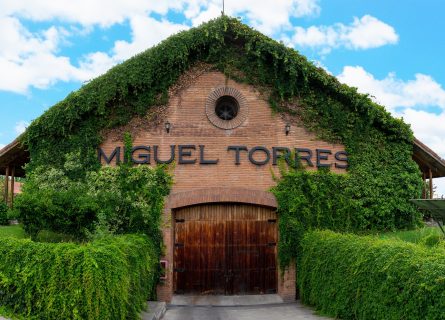
Twenty years ago, producers in the Central Valley were focused on making very ripe and opulent wines, a style that has subsequently fallen out of fashion.
As Marcelo Retamal, winemaker and consultant at Viñedos de Alcohuaz, once observed:
“Before 2011, we had ripe wines with high alcohol that were very dark in color, over-extracted and had a sweet flavor because of the alcohol concentration and heavy use of oak. We were taught at university to pick the grapes when they were all fully ripe. When you harvest raisins, whether they are Cabernet Sauvignon or Merlot, they all taste the same.”
However, this paradigm no longer applies: Chile’s winemakers have been listening, and the pendulum has swung decisively back in favor of elegance and terroir expression. As a result, many estates have significantly reduced the amount of new oak used in the production of Cabernet Sauvignon, in addition to easing off on the extraction and post-fermentation macerations. Earlier harvests and better site selection have also played an important part, yielding fresher and brighter wines.
As a result, the Valle Central now caters to an expanding majority. Granted, some blockbuster-style reds are still produced in Maipo and Rapel, with enough flesh and muscle to satisfy consumers who demand power and alcohol from their wines. There will always be a place for these super-rich archetypes, and it is not for us to judge. Yet they are outnumbered – and outgunned – by the striking personality of old vine Pais, high-altitude Syrah, and spicy Carmenère. A wealth of diversity is waiting to be explored in the Central Valley despite Cabernet’s allure with the collector crowd.
Key subregions
Maipo
Ironically, Maipo has the smallest vineyard area (11,000 ha) of the Central Valley’s key regions, and yet it is arguably the most successful zone. Located directly south of Santiago and home to the great and the good of Chilean winemaking, this is where Santa Rita, Concha y Toro, and Santa Carolina make their home. Cultivated on well-drained alluvial soils with some clay and gravel, Cabernet Sauvignon yields outstanding red wine here, occasionally sold at Bordeaux prices. The area’s unofficial ‘Grand Crus’ reside in the Andean foothills of Puente Alto and Pirque, where ripeness does not come at the expense of acidity. Meanwhile, the warmer Isla Maipo terroir delivers intense Carmenère and seductive Syrah.
Rapel
The very trendy vineyards of Rapel encompass the valleys of Cachapoal in the north and Colchagua to the south. The former enjoys a warm and dry climate (even by the standards of central Chile) and is heavily planted to red grape varieties: Cabernet, Carmenère, Syrah, and Merlot. In particular, Merlot has a real affinity with the brown clay soils of Cachapoal, producing an opulent facsimile of Pomerol. Elsewhere, winemakers are scaling the heights (rising to 1000 meters above sea level) in Alto Cachapoal in search of freshness and finesse.
Such qualities often define Colchagua’s best red and white wines, not least in the up-and-coming zones of Los Lingues (awarded its own DO), Paredones, and Apalta. Cooled by marine air, Paredones can rival Aconcagua in producing saline dry whites; the horseshoe-shaped valley of Apalta also shapes up nicely as a premier source of Chardonnay and Riesling. Silt, loam, clay, and volcanic soils have been exploited recently as site selection is increasingly important across the Chilean landscape.
Curicó
Over 22,000 hectares of vines are planted in Curicó, a region with very high potential. Dry farming is a distinct possibility due to the wetter climate, which is far more inclement than Casablanca or Limari. In the 1970s, Curicó was buoyed by the arrival of Miguel Torres, responsible for producing the region’s finest Cabernet: Manso de Velasco. It is joined by some very fine Pais, Chardonnay, Pinot Noir, and Sauvignon Blanc.
Maule
Maule is the largest DO in Chile, home to some 50,000 ha of prime vineyard real estate. And yet, a great deal of the acreage was historically used in bulk wine production, shipped to Western countries in large containers. But this is an enormous waste of Maule’s stellar potential: excellent soils include alluvial matter, granite, and quartz, while dry-farmed Carignan and Cabernet Franc continue to win international awards. Relatively high levels of rainfall and volcanic soils are also yielding very elegant Pinot Noir in the metamorphic terroirs of western Maule, pioneered by the great Miguel Torres Jr. Meanwhile, a delicious and very pungent sparkling wine, based on a resurgent Pais, has become a massive hit abroad.
Facts & Figures
Key wine styles
- Medium-to-full-bodied red and white wines; a small volume of sparkling
Appellation structure
- DOs Valle Central, Maipo, Rapel, Cachapoal, Colchagua, Apalta, Los Lingues, Curico, Maule
Hectares under vine
- 118,000
Average annual production
- 755 million liters per annum
Approximate number of producers
- 157 wineries
Sub Regions / Appellations
-
 Uncover the secrets of Curicó Wine Region in Chile. Experience its reliable and affordable wines, featuring Cabernet Sauvignon and Sauvignon Blanc. Read more
Uncover the secrets of Curicó Wine Region in Chile. Experience its reliable and affordable wines, featuring Cabernet Sauvignon and Sauvignon Blanc. Read more -
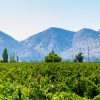 Discover why the Maipo Wine Region in Chile is often compared to Bordeaux and Napa Valley. Learn about its distinct climate, fertile terrain, and remarkable red wines. Read more
Discover why the Maipo Wine Region in Chile is often compared to Bordeaux and Napa Valley. Learn about its distinct climate, fertile terrain, and remarkable red wines. Read more -
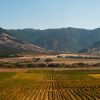 Uncover the Maule Wine Region Guide, featuring essential facts about grape varietals and attractions in charming towns. Read more
Uncover the Maule Wine Region Guide, featuring essential facts about grape varietals and attractions in charming towns. Read more
Key Grape Varietals
-
Chardonnay
-
Muscat
-
Pinot Gris
-
Sauvignon Blanc
-
Sauvignon Gris
-
Riesling
-
Viognier
-
Cabernet Sauvignon
-
Cabernet Franc
-
Carmenère
-
Merlot
-
Malbec
-
Pinot Noir
-
Syrah
Central Valley gastronomy
Central Valley’s tourist infrastructure has few peers in South America: vineyard hospitality is now on par with the best resorts in Stellenbosch and Napa Valley, and the investment shows signs of abating. Yet, while the attractions of the valley are numerous, many oenophiles head for the bright lights of Santiago when the sun goes down. A fierce rival to Buenos Aires, the city boasts a fantastic selection of restaurants and wine bars, serving everything from ceviche (seafood cured in citrus) to Conejo guise (rabbit and potato stew), grilled meats, fresh seafood, and much more besides. Wash it all down with Maipo Cabernet and Colchagua Sauvignon Blanc.
Wineries Recommended by Cellar Tours
Colchagua Valley
-
Cono Sur
Read more -
Los Vascos
Read more -
Viu Manent
Viu Manent, established by a Catalan family in 1935, excels in Chilean cool climate wines, especially Carmenère, focusing on quality and family heritage. Read more
Curicó Valley
Maipo Valley
Rapel Valley
Nearby Charming Towns and Cities
Further Reading: Discover More Related Blog Content
More information
If you would like us to customize an exclusive luxury tour, contact us and let us know your travel plans. We offer luxury food and wine tours for private groups of a mininium two guests. In addition, all of our private, chauffeured tours are available year-round upon request.

